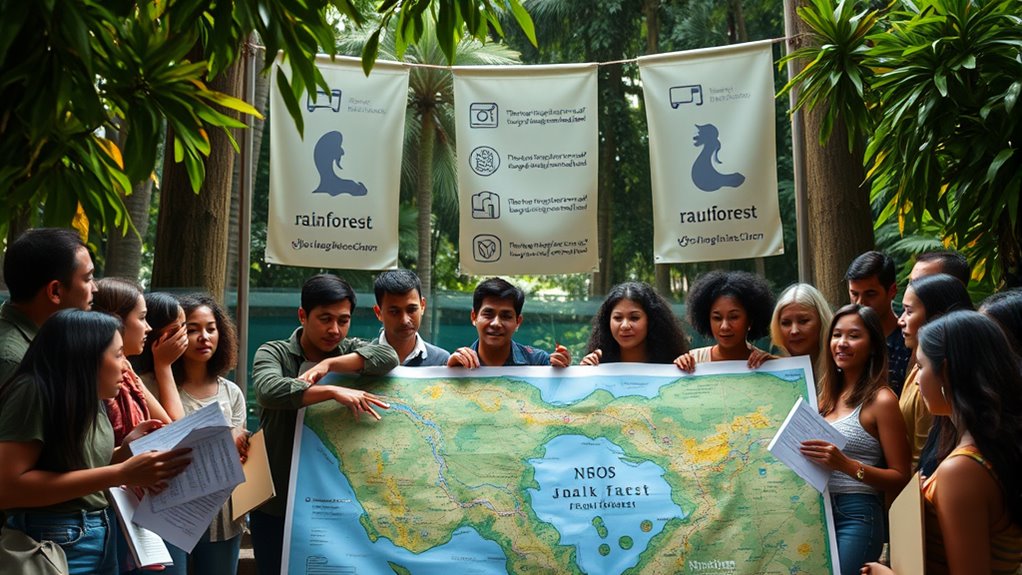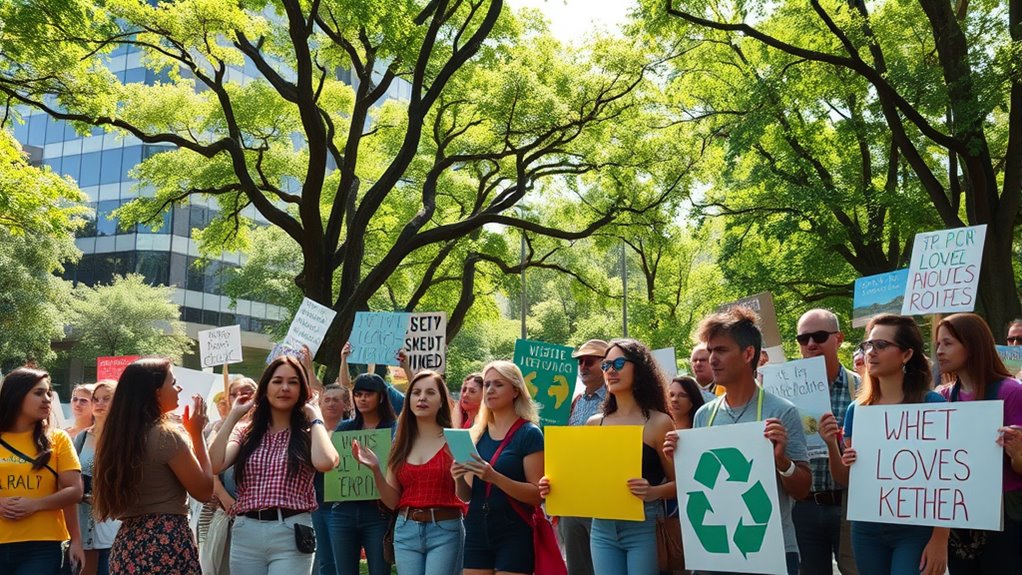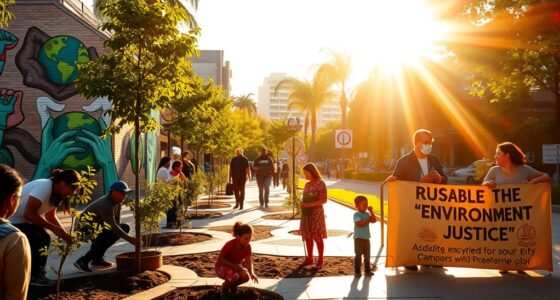NGOs influence environmental policy by building strategic partnerships with corporations, pushing for eco-friendly business practices, and raising public awareness through campaigns and grassroots mobilization. They rally communities to demand change, sway public opinion, and push policymakers toward sustainable actions. Their combined efforts create systemic industry shifts and strengthen policy reforms. If you want to explore how these strategies work together to shape a greener future, you’ll find insightful details ahead.
Key Takeaways
- NGOs form strategic alliances with corporations to promote sustainable practices and influence supply chains and industry standards.
- They mobilize communities through grassroots campaigns, protests, and petitions to sway public opinion and policymakers.
- NGOs utilize media and innovative communication strategies to raise awareness, gather support, and pressure governments.
- Combining systemic approaches with grassroots efforts amplifies advocacy and accelerates environmental policy change.
- Building partnerships with businesses and communities helps NGOs shape and implement more effective, environmentally conscious policies.

Have you ever wondered how non-governmental organizations (NGOs) influence environmental policy? It’s a mix of strategic alliances, active campaigning, and grassroots efforts that make their voices heard. NGOs often build corporate partnerships to push for sustainable practices and responsible corporate behavior. By collaborating with businesses, they can shape policies that encourage eco-friendly operations, influence supply chains, and promote corporate accountability. These collaborations help NGOs access resources, gain visibility, and leverage the influence of large corporations to effect change. For example, they might work with a major retailer to reduce plastic waste or partner with an energy company to promote renewable energy initiatives. Such collaborations make it easier for NGOs to translate their advocacy into tangible policy shifts, as they align the interests of corporations with environmental goals.
NGOs influence environmental policy through corporate partnerships that promote sustainability and responsible business practices.
But grassroots mobilization remains a powerful tool in their arsenal. NGOs rally communities to take action on local and global issues, turning individual concern into collective pressure. When you’re part of a grassroots movement, your voice adds weight to the call for policy change. NGOs organize protests, awareness campaigns, and petitions that draw public attention to pressing environmental problems. This grassroots energy can influence policymakers, especially when it reflects widespread public concern. When many people come together to demand change, politicians and regulators tend to listen more closely. By empowering local communities to hold corporations and governments accountable, NGOs amplify their impact and foster a sense of shared responsibility for the environment. Additionally, leveraging public engagement strategies helps NGOs expand their reach and effectiveness. Incorporating innovative communication methods further enhances their ability to mobilize support and influence policy decisions. Recognizing the role of predictive analytics can also help NGOs better anticipate public needs and tailor their campaigns for greater impact.
These two approaches—corporate partnerships and grassroots mobilization—complement each other. While partnerships can lead to systemic change within industries, grassroots movements can sway public opinion and political will. NGOs often use media campaigns to highlight successes and mobilize support, creating a feedback loop that keeps pressure on policymakers. They also provide a platform for ordinary people to engage in environmental activism, making the issue more accessible and urgent. This combination ensures that environmental advocacy isn’t just top-down but also bottom-up, creating a thorough push toward better policies. Additionally, the role of projected influence from innovative technologies and strategic messaging further amplifies their impact on policy development.
In essence, NGOs understand that influencing environmental policy requires building bridges—whether with corporations to adopt sustainable practices or with communities to generate grassroots pressure. You can see their influence in the way policies evolve, becoming more environmentally conscious and inclusive. Through strategic partnerships and grassroots mobilization, NGOs turn public concern into meaningful action, shaping the future of environmental policy in ways that benefit everyone. Moreover, the integration of public awareness campaigns enhances their ability to mobilize support and accelerate policy change.
Frequently Asked Questions
How Do NGOS Secure Funding for Environmental Campaigns?
You secure funding for environmental campaigns by engaging donors through compelling communication and transparency. You also navigate grant application processes carefully, highlighting your project’s impact and sustainability goals. Building strong relationships with individual donors and institutions increases your chances of receiving financial support. Consistently demonstrating your NGO’s effectiveness and aligning your campaigns with donor priorities helps you secure the necessary funds to advance your environmental initiatives.
What Are the Main Challenges NGOS Face in Policy Influence?
Imagine trying to navigate a ship through a storm, just like NGOs face hurdles in policy influence. You encounter challenges like limited resources, resistance during policy implementation, and difficulty engaging stakeholders effectively. These obstacles make it hard to sway decision-makers or ensure policies are enforced. You need strategic stakeholder engagement and persistent advocacy to surmount these issues, ensuring environmental policies are impactful and sustainable despite the turbulent waters.
How Do NGOS Collaborate With Governmental Agencies?
You can see that NGOs collaborate with government agencies through effective partnership strategies, fostering mutual trust and shared goals. You engage stakeholders by participating in consultations, advisory committees, and joint initiatives, ensuring that diverse voices influence policy decisions. This active collaboration helps NGOs shape environmental policies, leverage resources, and implement projects more effectively. By maintaining open communication and aligning interests, NGOs and governments work together to address environmental challenges efficiently.
What Metrics Are Used to Measure NGO Impact in Policy?
Imagine you’re evaluating an NGO’s influence on environmental policy. You’d use impact assessment to measure how policies change due to their advocacy. For example, if new regulations reduce emissions, that indicates policy effectiveness. Metrics include policy adoption rates, legislative changes, and environmental improvements. These indicators help you determine the NGO’s actual impact, showing whether their efforts lead to meaningful environmental progress.
How Do NGOS Ensure Community Representation in Environmental Advocacy?
You can guarantee community representation in environmental advocacy by prioritizing community engagement and grassroots participation. Actively involve local communities in decision-making, listen to their concerns, and incorporate their perspectives into campaigns. Organize town hall meetings, workshops, and outreach programs to foster trust and collaboration. By empowering community members and valuing their input, you build a more inclusive advocacy approach that truly reflects the needs and interests of those affected.
Conclusion
In the end, your role in supporting NGOs shapes environmental policy like a modern-day Robin Hood, fighting for nature’s justice. By staying informed and involved, you help guarantee these organizations continue their essential advocacy. Just as the printing press revolutionized communication, your voice can amplify change, making a real difference. Together, you and NGOs can rewrite the future, proving that even in an age of digital dragons, dedicated activism remains a powerful force for our planet’s well-being.










